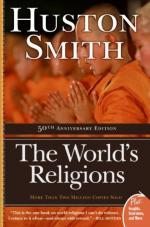
|
| Name: _________________________ | Period: ___________________ |
This test consists of 15 multiple choice questions and 5 short answer questions.
Multiple Choice Questions
1. How did Judaism affect human coexistence?
(a) Judaism laid the foundations of communism.
(b) Judaism established the need for moral restraints in the danger zones of human existence.
(c) Judaism justified the use of slave labor.
(d) Judaism set the pattern for preemptive wars.
2. What is the totem?
(a) A tribal village name
(b) A heavy burden that the tribe must bear
(c) An idol for offering sacrifices
(d) An animal species which comes to symbolize a life force
3. What are the two interpretations of messianic hope?
(a) A utopia or a conquest
(b) A person or messiah or a catraclysmic intervention by God
(c) A population boom or a military power expansion
(d) A person or the end of the world
4. When did Muhammad receive his commission as the Prophet?
(a) On Ramadan 1, 700 A. D.
(b) Around 610 A. D.
(c) About five centuries after Christ
(d) About 300 B. C.
5. How does the primal religion differentiate between place and space?
(a) Place as opposed to space where the former is concrete and the latter abstract
(b) Place is really abstract; whereas, space is concrete
(c) Place is where you are and space is where you go
(d) Place is an exact location and space is the air around place
6. How does an Andean view the landscape?
(a) As proof there is no superior being
(b) As a reflection of a superior reality
(c) As just a landscape
(d) As a problem that must be solved
7. How do Muslims justify Islam's history of aggressiveness?
(a) That it was no different from other major religions.
(b) That it never happened at all
(c) That it was misrepresented by European historians
(d) That is was needed only at the beginning of the religion
8. What is the greatest threat to the primal religions?
(a) Disbanding of tribes
(b) Passing time and literacy
(c) Modern interpretation
(d) No missionary efforts
9. What area of the world did Christianity quickly take over?
(a) The Mediterranean
(b) Most of Asia
(c) The Middle East
(d) The Americas
10. What are the three areas of mysticism in Sufism?
(a) Love, ecstasy, intuition
(b) Prophecy, interpretation, seances
(c) Faith, hope, charity
(d) Communication with the dead, using hallucinogens, speaking in tongues
11. How can the gods of cultures other than the Jewish people be described?
(a) Immoral, indifferent and capricious
(b) Personal, effective, and powerful
(c) Idealstic, ethereal, and silent
(d) Loving, gracious, and kind
12. What was evident in the bearers of the Good News?
(a) Their release from fear, guilt, and ego
(b) They all had university degrees
(c) The different way they dressed
(d) That they were uneducated
13. What passion within the Jewish people did their conquest inspire?
(a) The passion for money
(b) The passion for history
(c) The passion for freedom
(d) The passion for war
14. What was the main cause of the rise of Protestantism?
(a) Different interpretation of scripture
(b) Acceptance of Eastern orthodoxy
(c) Eccliastical excesses in the Roman church
(d) Language barriers
15. How is al-qur'an divided?
(a) Into 114 chapters or surahs of varying lengths
(b) Into two parts of history and laws
(c) Into 99 chapters of varying lengths
(d) Into six books of equal length
Short Answer Questions
1. To the aboriginal, what is the purpose of the ancestors?
2. What was the avowed purpose of Jesus?
3. What creates the theater of the primal religion handed down orally?
4. What is the attitude toward the idea that humans are the holder of absolute truth?
5. How does Huston Smith classify primal religions?
|
This section contains 648 words (approx. 3 pages at 300 words per page) |

|




